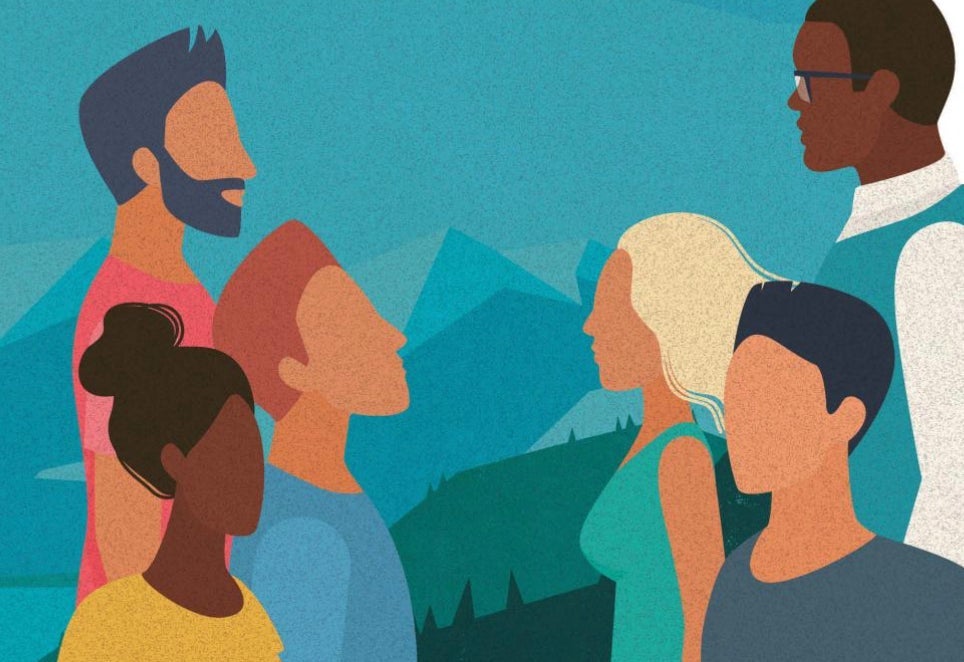The United States of America is in the midst of a national reckoning. In a land predicated on the notion of “liberty and justice for all,” we have long struggled with the glaring contradiction that not all men and women are treated equally. Even those of us who work in the seemingly neutral professions surrounding adventure sports and environmental conservation are complicit in the perpetuation of cultural disparities, limiting access to public land and outdoor industry careers. In the last few years, things have improved, but the pace of progress is concerning.
It was the 2020 shooting of Ahmaud Arbery—killed by three white men while jogging on a public street—that finally caught the outdoor industry’s attention. As protests erupted over the murders of George Floyd and Breonna Taylor, companies and institutions across many industries scrambled to show solidarity. Suddenly, there was a sense of urgency among CEOs, human resource managers, and public relations professionals to do a better job of representing the full spectrum of humanity, particularly those who identify as Black, Indigenous, and people of color (BIPOC). The outdoor industry was no different, yet in many ways, we have a lot of work yet to do.
With lofty promises, industry organizations large and small have signed The Outdoor CEO Diversity Pledge, created by social activist Teresa Baker and outdoor consultant Chris Perkins to hold companies accountable to change. Other brands have signed people of color as sponsored athletes or hired product designers and merchandising experts to create culturally authentic styles and fashion options. Boards of directors are moving slowly to become more racially diverse, while individuals and affinity organizations, like Outdoor Afro, Latino Outdoors, Native Womens Wilderness, and others are working to establish guidelines for equitable compensation and career advancement for BIPOC. That much is happening, and it’s exciting.
Still, the industry can do much more. Despite the fact that most of the legal barriers to accessing the great outdoors have been lifted, our trails, campgrounds, and companies remain overwhelmingly white. Now, as we emerge from a traumatic year stained by a global pandemic and defined by a social justice movement, we have another opportunity to reconcile our values through our way of doing business. We can work proactively to create an industry in which everyone, regardless of race, ethnicity, gender, physical ability, or sexual orientation is not only welcome to participate but encouraged to succeed.
It seems, however, we are allowing this moment to pass without making substantive changes. Each of the signatories of The Outdoor CEO Diversity Pledge was asked to submit a report summarizing why the principles of justice, equity, diversity, and inclusion (JEDI) at their respective organizations are important. They were also required to identify what they hoped to achieve over the next five years.
“In December of 2020 we had 201 brands and companies sign the pledge,” said Baker. “Today we have 180. If they didn’t submit a report, we removed their ass. I don’t have time for games. You don’t just get to say, ‘Black Lives Matter.’ You don’t get to say you care about this work and then do nothing.”
Herein lies my skepticism. Though not a particularly difficult task, 21 companies failed to even articulate their desire to achieve JEDI in their places of business. For those that did, their reports are public—and in most cases, they’re frustratingly vague and short on details. We can manage only what we can measure and thus, companies and institutions must have a set of quantifiable goals. They must commit, for example, to increasing the number of BIPOC employees by two percent over a set period of time. And to achieve a goal like that, organizations need to strategically plan for and invest financially in workplace diversity, hiring consultants that are well versed in what it takes to dismantle embedded systems of bias. And it’s important that these efforts are transparent to public scrutiny and demonstrate a willingness for company leadership to be held accountable if they fail.
“No matter what happens, an organization must be willing to share where they are and why they are or aren’t achieving their goals,” Perkins said. “The learning is so much more valuable for the community when companies highlight the places where they’re not quite there yet, rather than producing a report strictly full of successes.”
Companies must boldly claim their intentions to change and work within the broader community to achieve the goals we all desire. They must do a better job of reaching out to every sector of the population so that no one is left out. Marketing managers must create campaigns and media collateral that are culturally relevant to specific ethnic groups and racial identities so that people from all walks of life can see themselves represented. They must build relationships with institutions of higher learning, like Historically Black Colleges and Universities, to attract a more diverse pool of job applicants. Professional organizations like the Greening Youth Foundation, for example, offer a suite of skills and expertise to make direct introductions to campus career advisors and alumni mentors who can help. Hire them! Organizations must also create training programs that encourage the cultural competency of management teams that can establish workplace environments that are safe and supportive for all. Regarding marketing and communications efforts, we can’t simply show more Black and brown faces in social media posts and campaigns. Diversity initiatives should be authentic to the experience of community brand ambassadors, and those ambassadors must be fairly compensated for their time and expertise—not paid in gear or media exposure.
As we venture back into the outdoors fully vaccinated, I fear that as an industry, we’re already starting to forget the shame and heartache of the last year. Once this “Oh shit!” moment has passed, I sincerely doubt that most institutions will stick to the pledges they made, however vague, and will opt instead for paths of least resistance. Motivated by fear, I believe we’ll see many companies opt for safe choices rather than risk the social media fallout from making a mistake while doing the important work of JEDI. Few will likely realize that they only fail if they give up on trying.
Some might insist that things are different now, that this time the outdoor industry has truly changed. I don’t believe it has. For those who disagree, I pose a simple challenge: dare to do better and prove me wrong.


